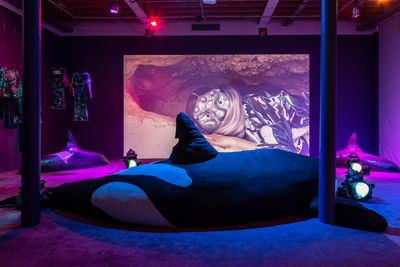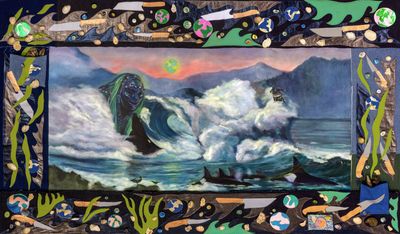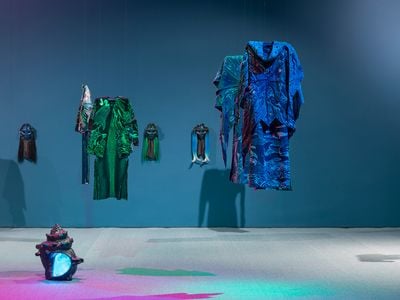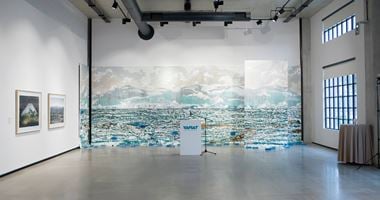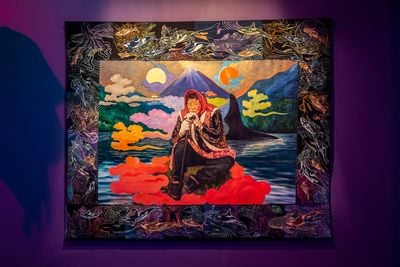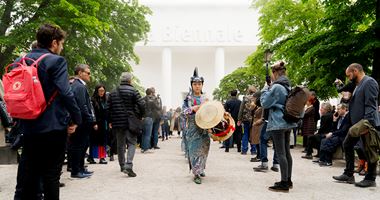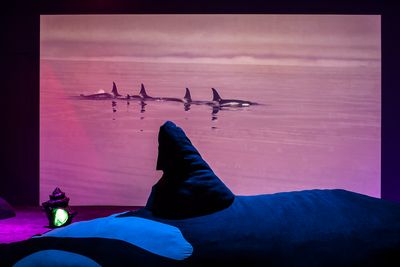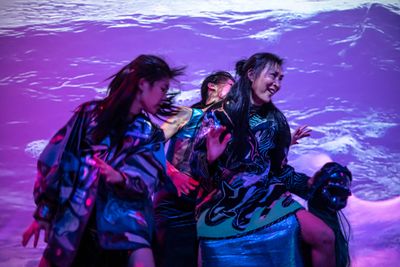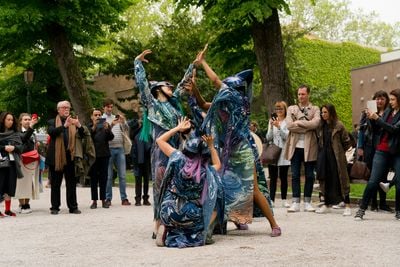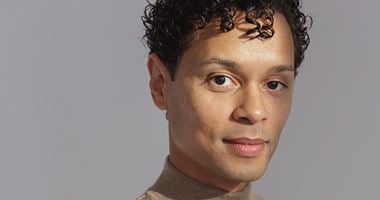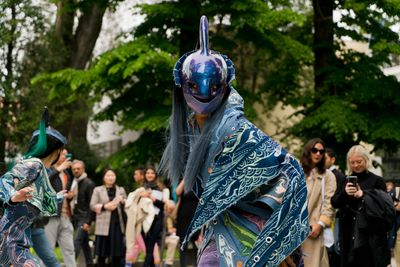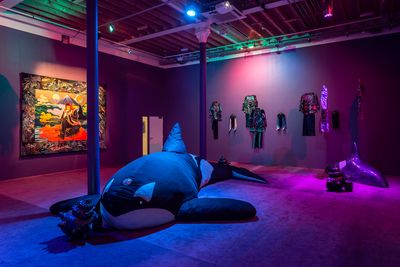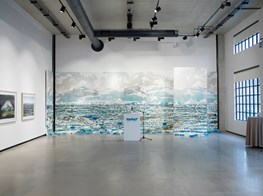Zadie Xa: Behind the Mask
Zadie Xa. Photo: Benito Mayor Vallejo.

Zadie Xa. Photo: Benito Mayor Vallejo.
'Welcome', a woman's voice intones, encouraging audiences to make themselves comfortable. The recording of the voice continues in its soothing manner; visitors are invited to lean against a huge stuffed fabric Orca, encapsulated by dorsal fins and tail. The narrator recounts the tale of Grandmother Mago, a mystical giantess who brought the world into existence, displaying a masked figure on screen who selects stones from a beach, crawling into fissures in the rock, moving her limbs in a strange, unearthly way.
This is Child of Magohalmi and the Echoes of Creation (2019): artist Zadie Xa's playful re-imagining of an ancient Korean creation myth, explored through a multi-media installation, and with performances by dancers Iris Chan, Jia-Yu Corti, Mary Feliciano, and Yumino Seki, with accompaniment by percussionist Jihye Kim. The exhibition was developed by Xa in collaboration with artist Benito Mayor Vallejo, with whom Xa designed the costumes and masks that appeared in performances staged at Art Night London in July 2019, and as part of the 58th Venice Biennale (11 May–24 November 2019). Child of Magohalmi and the Echoes of Creation was co-commissioned by Art Night, London, and the three institutions where the project has been staged: YARAT Contemporary Art Space, Baku (12 July–29 September 2019); Tramway, Glasgow (26 October–16 December 2019); and the De La Warr Pavilion in the British seaside town of Bexhill, where it will be on view between 1 February and 22 November 2020.
Xa originally studied painting, earning her BFA at Emily Carr Institute of Art and Design in 2007 and an MA in Painting from the Royal College of Art in 2014. Her work has continuously explored concepts of identity, particularly in relation to Xa's experience as a Canadian artist of Korean heritage, existing within the Asian diaspora. In Child of Magohalmi and the Echoes of Creation, Xa delves into this by layering traditional Korean mythology and culture over video captures of J pod—a group of critically endangered southern resident killer whales—who have been spotted off the coast of Xa's hometown, Vancouver. The installation recalls matriarchal religious structures and societies by mirroring 'Granny', a real-life orca matriarch of the J pod with the figure of Grandmother Mago, and employs performance as a means for Xa to embody and honour the historical women who paved the way for her existence and artistic practice.
In this conversation, Xa looks back on her artistic development as she reflects on Child of Magohalmi and the Echoes of Creation, her most ambitious project to date.
EWYou began creating artwork with oil paints on canvas, but have since shifted towards immersive installations composed of textiles, video, and performances. Could you talk about the evolution of your practice from the two-dimensional into its current form, and how your lines of inquiry have evolved in tandem?
ZXI studied conventional painting all throughout my undergrad and my master's, and I think it's something I really identified with as a younger artist and young student. The ideas that I had always wanted to explore and express in my work were never done successfully with painting, because if you're solely painting, it can be really inward-looking and a bit insular in terms of negotiating its own history. I felt really weighed down by what the possibilities of paint could do for me, and I felt like it always needed to be referential to art history because painting was taught to me through the conventions of the European institution.
For a long time, I was making theatrical landscapes populated by costumed figures, which is interesting because that's basically what I'm doing now but with performance.
Making good paintings doesn't just mean you're good at handling a brush, or that you can render an image realistically; it's about what you're communicating. Working on a two-dimensional canvas was really hard for me, because the ideas I had were much more layered. For a long time, I was making theatrical landscapes populated by costumed figures, which is interesting because that's basically what I'm doing now but with performance.
After graduate school, my husband suggested getting a sewing machine, because he had known that I was interested in textiles; but I was still thinking about how you could make that into a painting. I thought about what I was really excited by within the ideas of painting, and it was always something to do with transformative figures or the idea of shapeshifting. I thought, I'm going to cut all of this art-theorising in order to get to making the work: I'm just going to make a jacket.
I still consider my practice to be painting-based, because of the way I'm thinking about composition, whether it's sound or video or performance. Even the installation goes back to the facility of me knowing how to structure an image.
The jump from painting to making textiles was easy for me, because I took the jacket or cape form, which could be laid flat on the wall so that it's two-dimensional, and it was still something that I could negotiate in terms of picture-making. It was actually quite an abrupt shift, but I felt like it was something that was a long time coming, so it made sense while I was doing it. I still consider my practice to be painting-based, because of the way I'm thinking about composition, whether it's sound or video or performance. Even the installation goes back to the facility of me knowing how to structure an image.
EWHow does thinking compositionally effect the different stagings of an exhibition for you?
ZXI have to understand each space before the work goes in there. Even if it's the same exhibition, it has to shift and change, and it has to be made bespoke to the space. For Art Night in London, Child of Magohalmi and the Echoes of Creation was first shown in Walthamstow Library, so we couldn't change or transform it into an exhibition space. We changed it a bit with the lighting and a few sculptures and props. When the exhibition went to Azerbaijan, I had to do a site visit. Obviously a lot of planning goes into it, as is the case with preparatory plans for a painting. Benito makes an entire 3D sketch-up model, and then in my head I can compose the painting this way. We did this for Tramway as well.
For Tramway, there was a new painting that was hung on the back wall. I didn't make that for Azerbaijan because I didn't feel like it was necessary—that space was very big, so it felt very different. Tramway is very tight and it's immersive in the sense that you're surrounded and it's a little bit intense. The space was so big at YARAT in Baku that it almost felt like you were floating through it. At Tramway, because it's much smaller, I felt like it was going to be a more intense exhibition. When you go with intensity or minimalism, you need to go all the way to make it look really intentional, so I thought I'd make another big wall piece as a way to anchor in the show.
It was really important that the iterations would all be transformative. There should be a change, like a shift in the universe. There should be new things that appear, or maybe a shift in colour. The show at Tramway was purple and pink, but in Azerbaijan it was blue. This is important to me, that there's this kind of transformative element that's special for the space that it's in. I want to be respectful of the space, to let it know that I've created something special for it, and to consider the audience as well. It's important to me that people don't feel as if they're getting the exact same thing that they might have seen in an image elsewhere, just clumped into the space.
Outside of conceptual concerns, when any artist is making things that are more ambitious, it's impossible to do them alone. It's a complete fallacy, especially when artists are making work on a larger scale, and I'm not even making work on that big of a scale.
EWThe art you create often echoes the traditional Korean quilting techniques of jogakbo and pogaji, both conceptually and compositionally, in the way you piece together media from past works and combine them with new ideas. I'm thinking here of instances such as the masks and costumes from your Grandmother Mago (2019) performance at the 58th Venice Biennale and Art Night 2019 in London, which are included in the Child of Magohalmi and the Echoes of Creation installation. Is this a technique you plan on taking forward with you into the future? Are we to see elements of Child of Magohalmi and the Echoes of Creation in your work to come?
ZXI think so. Again, it's the idea of transformation, particularly with the costumes from Venice being used in future iterations of this show because they were linked together. It was actually very practical, because I was invited to do both projects around the same time. I thought Grandmother Mago would be a nice precursor to an extended iteration of what these ideas meant to me, or what I was trying to unearth with the research. I think in the future there will definitely be some themes that will carry through, and hopefully then new ideas will come from that as well.
EWThere are motifs that have reappeared throughout your work over the years, such as shells, knives, and yin-yang symbols. Do you find that these ground your practice in a way that aids your creative process?
ZXI feel like I've dropped the yin-yang because I'm not as attached to that symbol anymore, and I've not used the knife much lately. With this collection of images, I've created my own vocabulary and I've continued to hold on to some and let go of others.
This year, I've pulled myself out of the performances, because in some ways I felt I was allowing myself to be eaten—you're presenting yourself in the centre, and I like the idea of being able to take that away when I don't want my face to be in the work.
The shell, for me, is important as a symbol of communication. I first came across those specific horned turban shells in South Korea. They are collected by Korean diving women, known as haenyeo, on Jeju Island. When I went there, I was overwhelmed by how beautiful everything was and was romanticising everything. I am not from Korea, but my family is. They really have become a symbol of that trip I took, and they held so much sentimental importance for me.
But also, I began thinking about the idea of a phone or a tele-communicator and how that instrument would access a direct connection between me and, let's say, a fictional grandmother, ancestors, or these characters that I imagine and embody through my work. I also began thinking about how I would be able to access them through these communicators, and how they become these objects that are rooted in reality but also somehow propel me whilst I'm making the work, and also the audience, into a parallel dimension.
EWYou collaborate with your husband, artist Benito Mayor Vallejo, on all shows and production. I wonder if you could you talk more about the collaborative aspect of your art?
ZXCollaboration has become so... important isn't even the word. It's just necessary for the work. Outside of conceptual concerns, when any artist is making things that are more ambitious, it's impossible to do them alone. It's a complete fallacy, especially when artists are making work on a larger scale, and I'm not even making work on that big of a scale. With the music element, I started working with Jihye Kim, a traditional Korean percussionist who specialises in Korean Shamanic rhythms. That was such a coincidence, because when I first met her, I had no idea that was what her specialty was—I was just looking for someone who could play traditional Korean drumming. We've been collaborating for the past two and a half years. I've been working with the same four dancers for the past year who are really fantastic and come replete with a wealth of knowledge about dance, but who are also really generous with their own creativity and are always striving to understand how best to translate the work.
With Benito, who is an amazing artist but also my partner, I feel like our collaborative practice really started when we met at university in Vancouver. He is an incredible draughtsman and maker; he even helped me on my painting degree show in 2007. For the past two and a half years it's been a professional collaboration, but he's always lent a hand and been supportive. We've been together for so long and he really knows me, so the work comes from a really personal space and he understands. We're able to have important conceptual conversations about what makes sense, what could be added, and what should be taken away. I wouldn't be able to produce these types of shows on my own. It's not just practical, it's essential. These close conversations are really important to have, with the dancers, Jihye, and Benito; It's imperative if the work is to keep moving forward.
EWDo you see the inclusion of your physical presence in your work, from your performances to your self-portraits in exhibitions such as Homeboy 3030: Return to The Tiger Mountain at Union Pacific in 2018, as a purposeful act of claiming space?
ZXI think it's very slippery. When I first started putting myself in my work I was thinking back to when I was a young person and I really wanted to have someone who looked like me to be in the centre. When you're doing it in a performative manner, it's very empowering because you're basically the creator of your own universe. You can present yourself in any way and make yourself powerful, but it's a double-edged sword.
This year, I've pulled myself out of the performances, because in some ways I felt I was allowing myself to be eaten—you're presenting yourself in the centre, and I like the idea of being able to take that away when I don't want my face to be in the work. In the video Child of Magohalmi and the Echoes of Creation (2019), for example, I never take off the mask. We did shoot a lot of scenes with me not wearing the mask, and I just felt like I didn't want my face to be in it. I wanted that separation from it.
EWCould you elaborate on your position with regards to self-representation?
ZXI do notice that when I am asked by publications if they can print things, it is always my face. It's fine, but I also started feeling a little bit wary about the idea. I think that there's a way in which artists can involve themselves without pushing the work. I'm interested in representation and how I'm represented, or how people of colour, or women, are represented.
I didn't want to continually place myself in the centre, because that is something that I wouldn't be comfortable with. That's another reason why I use masks in the performances, because it's a way to conceal my face. It's important for me to have that type of anonymity in order to present the characters as a bit ugly, or against conventional beauty standards, because they're not really seductive and that's the point.
EWYou've spoken in previous interviews about your interest in Korean Shamanism as a matriarchal spirituality passed down through generations. If you are the Shaman creating these ceremonial performances and spaces, what are you manifesting in your practice?
ZXI'm really fascinated with how the shaman is a figure in the in-between space. Coming from a diasporic position, one feels constantly in between. I always thought that was so interesting, because a shaman claims they can be the channel between the living and the dead. In a diasporic position, this is manifested in a longing for one's homeland. In my case, it's more of an abstract homeland, or a parallel universe or world, and wanting to create a trance-like state.
Folklore, performance, music, culture, clothing, and textiles are the most beautiful and exciting things for me across the globe. That preservation of human history is really precious to me
When Korean shamans enter a trance-like state, that's when they're able to communicate with spirits. That's the feeling I'm trying to evoke for myself when I'm watching or constructing a performance, or working on sound, because that's when you're able to explore and access that middle ground. My work is very physical, so the process of making it becomes performative and is sometimes almost more important than the work itself.
EWYou work borrows a lot of its imagery and inspiration from the ocean. What responsibility do you think art has to give back to nature?
ZXThat's another reason why I'm passionate about Orcas and specifically J Pod. They're endangered because they're not getting their food source due to water dams and water pollutants. It's something that I feel so strongly about, but at the same time I made a sculpture entitled Sisters and it's made out of jesmonite and it's being shipped around. These are conflicting things. I'm learning from a lot of artists' practices and about what's going on in the environment and it's really important that these discussions are happening so that we're thinking about ways to move forward. There need to be practical ideas of how we can shift the kind of waste we're producing. That's a little bit outside my work, but a real-life concern.
EWYour hometown of Vancouver forms the backdrop for Child of Magohalmi and the Echoes of Creation, overlaid by an ancient Korean creation myth, which you have re-imagined for the exhibition: a dedication to your heritage and the women of your family. The exhibition has travelled all over the world. Has performing and exhibiting around the globe changed your perspective of where you have come from and the experiences that have influenced your artwork up until the present?
ZXWhen I was a young person, I was definitely not excited or proud to be Korean. I wanted to assimilate into the white culture that I grew up in. I think there was a longing to be like everyone else. Nothing about my family's culture was interesting or exciting to me; it was something that I deeply wanted to separate myself from. It makes me really proud when people who are not Korean are excited by my work and are motivated to search for traditional folklore within themselves. Folklore, performance, music, culture, clothing, and textiles are the most beautiful and exciting things for me across the globe. That preservation of human history is really precious to me, and was the main reason I became interested in Korean shamanism, because of indigenous culture and religion in Korea.
Working with Child of Magohalmi and the Echoes of Creation in different countries has been exciting, because I want people to look into their own history. When it was in Baku, they wanted a performance, and I thought it would be great if we included some local artists in the show. I wanted to create a space that people could also claim as their own. We got all these proposals from artists who wanted to present work and were exploring different subjects, like female mythological figures in Azerbaijani mythology. I thought that was amazing—all this stuff that people were already interested in that tied into my work. All these ideas, mythological characters, even cultural practices; they're all tied into one another.
EWFinally, do you have any upcoming plans for the end of 2020, moving into 2021?
ZXOther than De La Warr Pavilion, I have a solo show at the Remai Modern in Canada in June 2020, and a solo at Leeds Art Gallery in October 2020. —[O]



